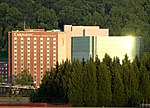Roanoke Downtown Historic District (Roanoke, Virginia)

The Roanoke Downtown Historic District is a national historic district located in the Downtown Roanoke area of Roanoke, Virginia. It encompasses 122 contributing buildings. It includes a variety of commercial, institutional, social, and governmental buildings and structures from the late 19th century to the mid-20th century. Notable buildings include the Roanoke City Public Library, the YMCA Central Branch Building, First Christian Church (1925), the Central Church of the Brethren (1924), Tomnes Cawley Funeral Home (1928), Thomas B. Mason Building (1961), Peerless Candy Co. (c. 1916), City Hall / Municipal Building (1915), Roanoke Times Building (1892), Anchor Building / Shenandoah Building (1910), Greene Memorial Methodist Church (1890), and United States Post Office and Courthouse (1930). Located in the district are the separately listed Patrick Henry Hotel, Boxley Building, Campbell Avenue Complex Historic District, Colonial National Bank, and First National Bank.It was listed on the National Register of Historic Places in 2002.
Excerpt from the Wikipedia article Roanoke Downtown Historic District (Roanoke, Virginia) (License: CC BY-SA 3.0, Authors, Images).Roanoke Downtown Historic District (Roanoke, Virginia)
Church Avenue Southwest, Roanoke
Geographical coordinates (GPS) Address Nearby Places Show on map
Geographical coordinates (GPS)
| Latitude | Longitude |
|---|---|
| N 37.270555555556 ° | E -79.943333333333 ° |
Address
Church Avenue Southwest 120
24011 Roanoke
Virginia, United States
Open on Google Maps








